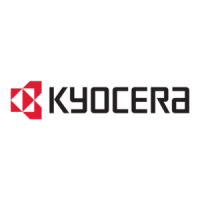Adhesive label paper must be entirely covered by its top sheet, with no spaces between the individual labels. Labels with spaces in between are apt to peel off,
causing serious jam problems.
Some label paper is manufactured with an extra margin of top sheet around the edge. Do not remove the extra top sheet from the carrier sheet until after
printing is finished. Top sheet (white bond paper) Adhesive Carrier sheet Figure B.1 Adhesive-back label Acceptable Top sheet Unacceptable Carrier sheet
Table B.4 lists the specifications for adhesive label paper.
Table B.4 Adhesive Label Specifications Item Weight of top sheet Composite weight Thickness of top sheet Composite thickness Moisture content Specification
44 to 74 g/m² (12 to 20 lbs/ream) 104 to 151 g/m² (28 to 40 lbs/ream) 0.086 to 0.107 mm (3.9 to 4.
2 mils) 0.115 to 0.145 mm (4.5 to 5.7 mils) 4% to 6% (composite) Figure B.2 Label arrangement B-5 B.3. Special Paper Envelopes The printer can print on
envelopes using paper with a basis weight of 60 to 79 g/m² (16 to 21 lbs/ream). Envelopes must be manually fed. An envelope is a more complex object than a
single sheet of paper.
For this reason, it may not be possible to obtain consistent printing quality over the entire envelope surface. Many envelopes have a diagonal grain
orientation. (See Paper Grain above.) This orientation is more likely to wrinkle and crease on its way through the printer. Before purchasing envelopes for
use with the printer, test a sample to verify the envelope's suitability. Do not use envelopes having an encapsulated liquid adhesive. Avoid long printing runs
consisting of envelopes only. Extensive envelope printing can cause premature printer wear. To avoid jamming due to curled envelopes, do not leave more
than approximately 10 printed envelopes stacked in the paper trays during multiple printing of the envelopes. Colored Paper Colored paper should satisfy the
same conditions as white bond paper, listed in Table B.
1. In addition, the pigments used in the paper must be able to withstand the heat of fusing during the printing process (up to 200°C or 392°F). Preprinted
Paper Preprinted paper should have a bond paper base. The preprinted ink must be able to withstand the heat of fusing during the printing process, and must
not be affected by silicone oil. Do not use paper with any kind of surface treatment, such as the type of paper commonly used for calendars.
Recycled Paper Select recycled paper that meets the same specifications as the white bond paper (See Table B.1 on page B-2.) except whiteness. Before
purchasing recycled paper, test a sample on the printer and check that printing quality is satisfactory. B-6 C.
1. Parallel Interface Appendix C Host Computer Interface This appendix describes the signals used in the laser printer's parallel, RS-232C/RS-422A
interfaces. It also lists pin assignments, signal functions, timings, connector specifications, and voltage levels. The RS-232C/RS-422A protocols are also
covered. Finally, it explains the use of the printer in a multi-computer environment. C.1. Parallel Interface Parallel interface communication modes The
printer features fast data transmission on the parallel interface. The parallel interface mode can be activated from the printer's control panel (see Chapter 2,
Operating the Laser Printer) as follows: Use a parallel printer cable that complies with the IEEE1284 standard. Auto [default] The printer automatically
changes its communication mode to the one the host computer is currently using.
Ordinarily, you should leave this setting unchanged. Nibble (high) High speed data communication is used in compliance with the IEEE 1284 standard.
Normal The printer uses the communication method discribed by to the normal definitions of the Centronics interface. High-speed This mode enables faster
data transmission between the printer and the host computer. (Select this mode if printing problems occur when the printer is connected to a workstation.
You're reading an excerpt. Click here to read official KYOCERA
FS-1750 user guide
http://somemanuals.com/dref/324820

